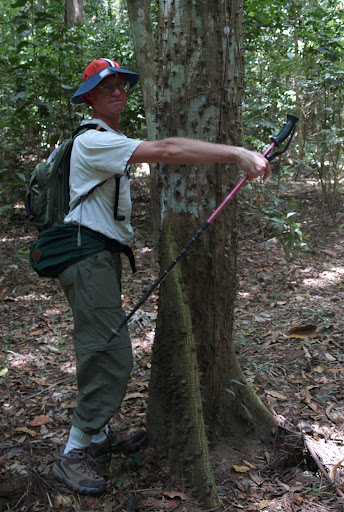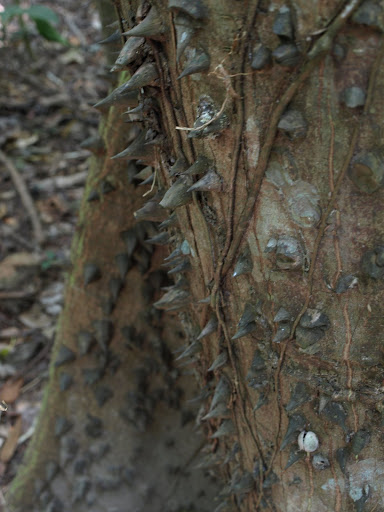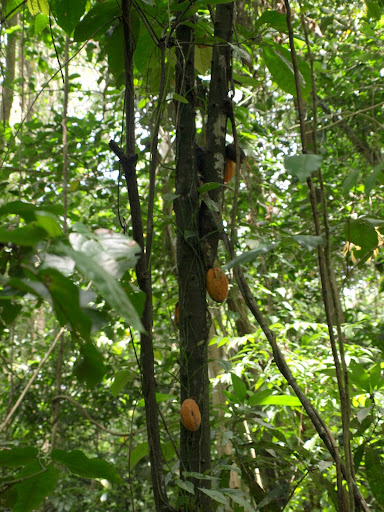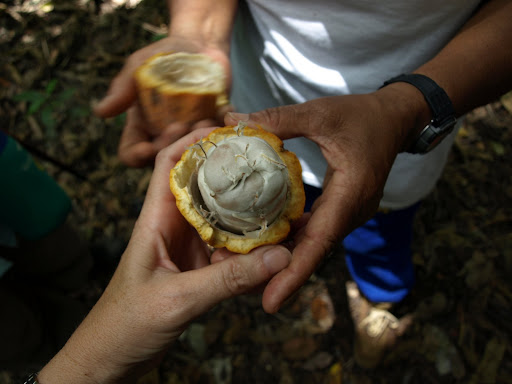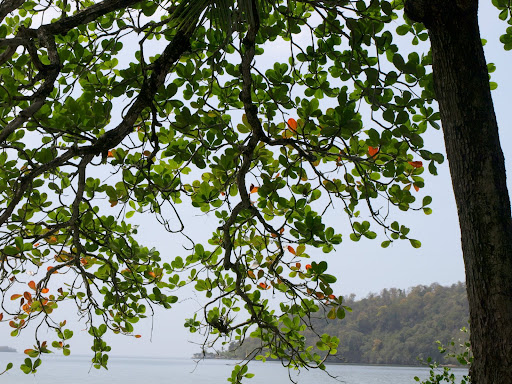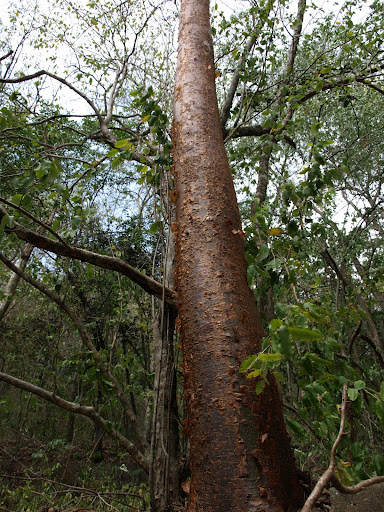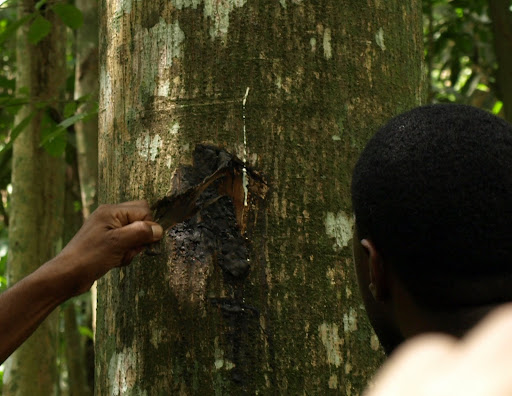
It’s strange to think that the Island of Trinidad would not be born for over 100 million years, when the leatherback turtles first roamed the oceans in the age of the dinosaurs. These massive sea turtles can grow to be 10 feet (3 m) in length, weigh over 2000 pounds (1000 kg) and live over a hundred years. The species has survived almost unchanged since the Jurassic era. They begin their life on land where they hatch from eggs, laid by their mothers in the sand above the high tide line. Shortly after hatching, they make their way to sea. The males never return to land but about half a dozen times between March and August, the mature females will laboriously drag themselves from their ocean home to build a nest and lay their eggs.
The islands of Trinidad and Tobago are the prime nesting site in the world for these amazing reptiles. Very little is really known about them since they spend nearly all their life at sea. Even their classification as reptiles is somewhat in question since they are able to regulate their body temperature. Our friends John and Margaret Cooper (UWI Veterinary Medicine) are leading a study of the nesting turtles in cooperation with local volunteer organizations that are working to preserve the species. Its not peak season yet but because Rich was here for only 10 days they helped us arrange a tour to watch the mother’s laying their eggs on the beach. I will go out with them again later in the season when the eggs are hatching to help them with their research.
We left St. Augustine a little after 5:30 pm and arrived in Matura on Trinidad’s east coast a little after 7:00 pm. Traffic is awful that time of day and the roads are terrible any time of day. I just got a car and so this was one of my first adventures in left side of the road driving but that’s another story. In Matura, John and Margaret delivered a bunch of supplies for the volunteers they work with and introduced us to some of their colleagues at Nature Seekers (a local group organized to protect the turtles). Nature seekers patrols the Matura beach each night from dusk to dawn during the laying season (March – August) to prevent poaching. They also guide tours and collect data on the turtles.
The turtle beaches are closed from sunset to sunrise during the egg laying season. To enter the beach at night you must have both a permit and a guide. Our guide, Ronald was fantastic. He was enthusiastic and regaled us with all sort of interesting information, like the fact that leatherbacks eat primarily jelly fish and have a special groove on their beaks for puncturing the man-of-war jellyfish. They roam hundreds of miles through the ocean and one was recorded diving over 4000 feet (4/5ths of a mile) below sea level before the depth sensor failed. When we went out to the beach around 8 pm the tide was out and Ronald told us that in his experience, the turtles usually come ashore with the rising tide, starting when the tide is about half way in. So we settle down on the beach.
The moon was nearly full and although it had rained hard on us during the drive, the sky was now dotted with only a few scattered clouds. It was wonderful just sitting in the warm night area watching the waves in the moonlight. Our tour group was quite small consisting of us, the Coopers, and a family from Germany with two young children. While we sat and waited, Ronald helped the children build a leatherback turtle in the sand taking the opportunity to teach the kids about the way they dug their nest, how they look and the ridges on their shells (leatherback turtles don't have plated shells like other turtles). After a bit, a second much larger tour group (over 2 dozen) came out to the beach and head down the beach to the south. The guides and patrols on the beach all carry radios so that if anyone finds a turtle, they can radio the other tour groups to come. We waited patiently on the beach for an hour or so. A bit after nine, John and Margaret decided they needed to head back to St. Augustine since John had an early morning class. They’ve seen many many turtles in their research and will be out studying them again in a few weeks so they didn’t feel the need to stick around late this night. Shortly after they left, Ronald decided that the tide had come in enough for us to start looking harder for turtles so we wondered south down the beach toward the other tour group for a while and then turned back north.
When we got back to our original sitting spot, Ronald and most of our group sat down to wait again but I thought I could see something dark on the shore ahead so Rich and I kept walking another few hundred feet. When we got closer, it became clear that the dark thing I’d seen was indeed a mother turtle coming ashore. We started waving and signally wildly to the rest of our group but they didn’t seem to be paying much attention so I ran back towards them while Rich kept an eye on the turtle. When I was about half way back to the group, they finally noticed my running and wild gesticulating, got up and started coming our way.
Ronald advised us all to stay about 40 feet (12 m) back from the turtle so as not to scare her off. When she was about half way up the beach, she decided she didn’t like the spot, turned and started heading back to the sea. Ronald then went over and had a chat with her and despite her reluctance he was able to persuade her to stay and lay her eggs for us. About the time she headed back up the beach, a second turtle starting coming ashore in almost the same spot. The two turtles settled in to dig their nests about 20 feet (6 m) from each other. Just about then, the second tour group, who’d been radioed by our guide, joined us.
The turtles began by excavating with their large front flippers throwing great arcs of sand away from their site. Once they’d dug themselves in about 8 inches (20 cm), they began digging the nest itself with their smaller rear flippers. At this point, the turtles become so intent on what they are doing that they are doing that they aren’t disturbed by humans so we were permitted to get up close to the turtles digging their nests. The turtle would take one of her rear flippers and run it around the bottom of the whole kind of like I might scrape the bottom of a mixing bowl with a rubber spatual, she would close her flipper around the loose sand almost like it was a hand and pull the sand out of the hole. She’d then repeat the process with the other flipper until she’d dug an almost perfectly cylindrical whole about 10 inches (25 cm) in diameter and maybe 20 inches (50 cm) deep.
When the nest was as deep as she could readily reach with her rear flippers, she began laying her eggs. Once the turtles begin laying their eggs they go into a trance like state and are virtually unaware of anything going on around them. At this point, we were allowed to take flash photos and even touch the turtle (see slide show below). Once she started laying, Ronald straddled her back to take her measurements and read the transponder chip that had been put in her during a previous season. He read the tags on her rear flippers while she was digging the whole. Our turtle (the first one that came ashore was 142 cm long, a bit on the small size and the other turtle was 153 cm long, just about average. Turtles usually lay 100 to 150 fifty eggs with yokes in a nest and then some smaller eggs without yokes. No one is quite sure what the purpose is of the smaller eggs. The eggs are spherical with soft leathery shells and a little bigger than a golf ball. The newly laid eggs were moist and glistened in the moonlight. Our turtle laid a truly impressing number of eggs, close to 150 fifty and then began covering them with sand using her rear flippers. Once she was satisfied that the eggs were adequately buried she began flinging sand about wildly with her front flippers. She slowly turned her self about flinging sand every which way as she went and ultimately creating a ring of disturbed sand at least 12 feet (4 m) in diameter and making a number of decoy nest sites along the way. By the time she was done, it was impossible to tell where in all that mess she’d laid her eggs even though we’d been right there watching the hole times.
(Note: To see a larger version of the slide show, click on the title (Turtles))
Having finished her task, our turtle began to slowly make her way back to the ocean. She seemed totally spent. The entire process had taken her over 2 hours. Even through our turtle started and finished laying her eggs before the other turtle, she took longer camouflaging the site so by the time she started back to the ocean, the second turtle was gone. First on the beach, last off. She slowly, slowly dragged her tired body that was not truly meant for maneuvering on land back toward the water. She hit the waters edge. One small wave came in and carried her out a couple of feet and she paused a moment. Then a bigger wave crashed over her and she was gone.

